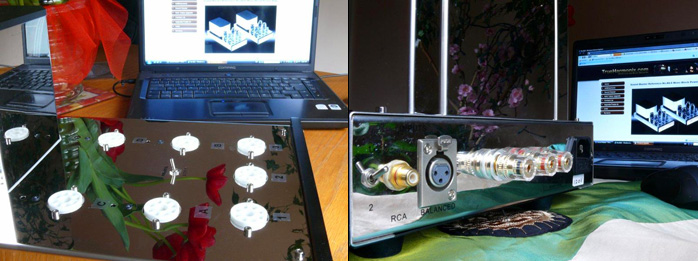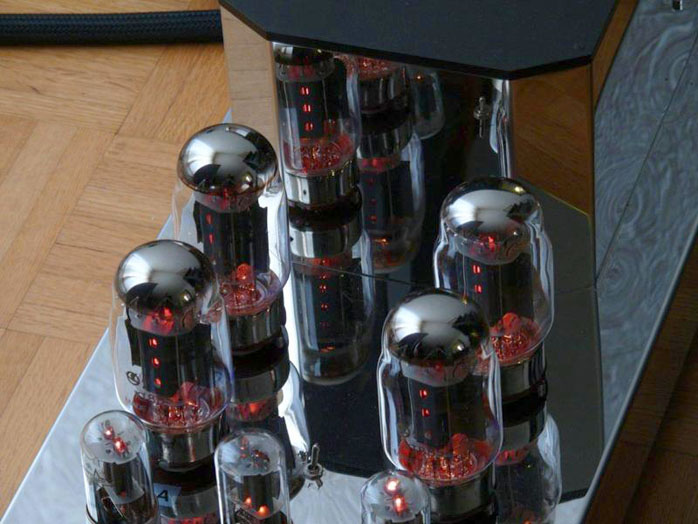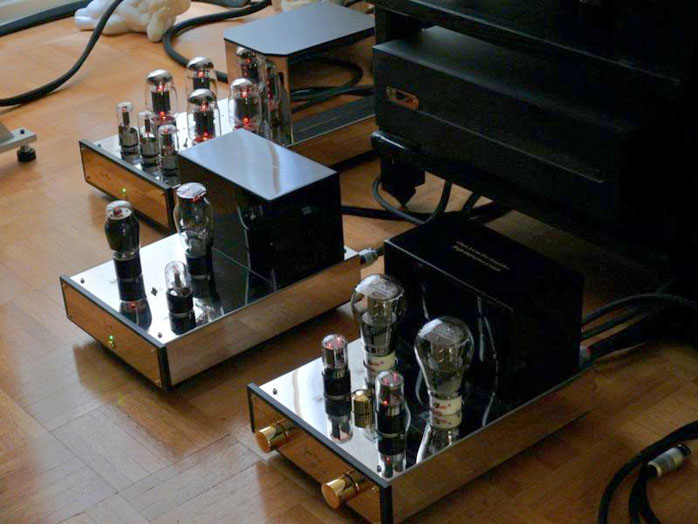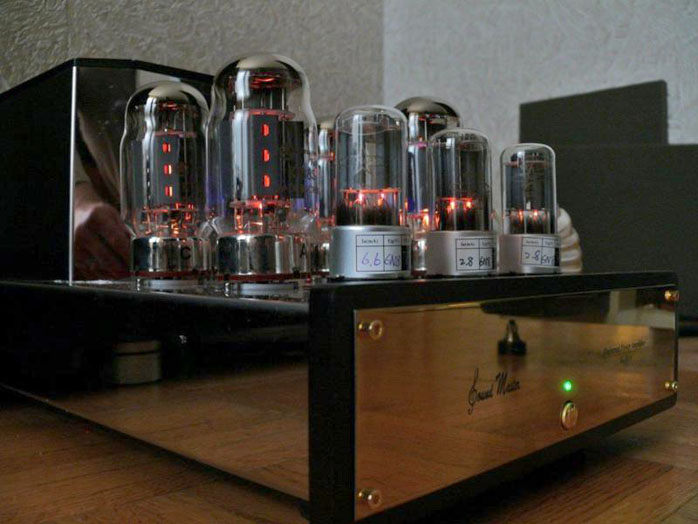This review page is supported in part by the sponsors whose ad banners are displayed below |
 |
The amplifiers on the other hand had no qualms about full-range delivery. They demonstrated powerful bass and sweetness at the extremes married to a refined and neutral midband showing the Sound Master No 88.6 capable of both quantity and quality. In triode mode, the KT88s traded their muscular status for midrange refinement, concentrating all the focus on authenticity of midrange and high-frequency tonal balance, gaining further sweetness and emphasizing detail in that range. The penalty was a diminished lower octave and loss of absolute dynamic proportions but the overall character came across as quite natural, midrange-centric and ultimately very satisfying.
|
 |
The most neutral frequency response was obtained in UL mode with superior bass and transparency. The highs were extended and detailed, giving up a little of triode mode’s refinement and sweetness for an increase in attack, neutrality and transient snap. The widest response was achieved with the Audio Space Reference 2S where the combination rivaled the midrange capability of the Sound Master’s PX4/ns tubes and added better extension in the lower octaves plus superior power. The amplifier’s overall character in UL was surprisingly similar to the Bel Canto 200.4, with the Sound Master adding a little bit of warmth in the upper bass and losing a little definition in the absolute low end. The Black Magic CD Mat was frequency neutral, neither taking away or adding anything to the equation other than the occasional removal of a level of false air on some recordings that some would equate with the loss of a bit of extra brightness.
|
 |
The No.23 Mk II Reference line stage produced the widest soundstage of any preamplifier tested in house and matched the Acoustic Buoy Scorpio. Depth was quite good but it also had the greatest forward projection of any of the units, resulting in a slightly more forward staging perspective. The preamplifier displayed this tendency with both the Bel Canto amplifier and No.88.6 Reference Mono Blocks. Images were three-dimensional with visceral solidity and a focus that exceeded my own Reference 2S on some material. The combination of the Sound Master preamplifier paired with the company’s own mono amps created an extremely focused soundstage and its reproduction of hall acoustic infused an excellent sense of hearing live instrument in real space that was slightly superior to the pairing with the Bel Canto.
|
 |
The No.88.6 Reference amplifiers had the ability to float a large three-dimensional soundstage with transparency on par with the Bel Canto. Both amplifiers easily translated subtle spatial cues in the source material. The tube amps were slightly more forward and exhibited greater projection but depth was slightly foreshortened by comparison. In ultralinear mode this was only to a minor degree but in triode images took on a nearfield perspective. Objects were larger and less pinpoint, with appreciably less focus and less differentiation of distances between instruments on the soundstage. In UL mode the amplifiers corrected this deficiency and showed considerably better focus and placement of objects on the soundstage.
|
|
|
The Black Magic CD Mat improved soundstage definition and specificity by virtue of increased resolution. This enhancement of focus contributed to a better illusion of real instruments in real space. The electronics were simply able to create a more accurate picture of the musical event by having access to better information. Placement on better recordings became more pronounced and mainstream recordings revealed greater subtlety.
|
 |
The Sound Master No.23 Mk II preamplifier was an interesting mixture of strengths and weaknesses. It had a caliber of midrange reproduction and focus that on occasion exceeded that of my Reference 2S. Its presentation was thoroughly involving and the character was overall in the same vein as my Audio Space preamplifier, approaching neutral but erring slightly on the side of involvement rather than observation. Soundstage reproduction was excellent, focused, expansive and convincing. These were formidable strengths and in these areas the Sound Master consistently drew praise in my listening notes. But a few weaknesses, most specific to the demands of my system, made the preamplifier maddeningly frustrating.
The most severe problem was gain or in this case, lack thereof. While the intended target audience will not find this an issue, those in borderline situations or with inefficient speakers will have problems. In single-ended mode, the preamplifier came tantalizingly close but still fell short. In balanced mode the additional loss of gain was crippling, which was unfortunate because the qualitative advantages, though small, were audible.
|
 |
The gain problem cascaded into the secondary one of achievable dynamics. Audiophiles who own efficient systems should be able to sidestep this issue and will probably find the dynamic palette of the No.23 Mk II quite wide and the clipping characteristics forgiving. It has the potential to be satisfying if coupled with loudspeakers that have sufficient efficiency to allow the preamp to operate at optimal range. In my system, I found that at lower playback levels, the dynamics showed evidence of life but with the disadvantage of limited maximum output, this potential was never realized.
And the final issue is low bass. The preamplifier showed a lack of fortitude in the lowest octave. This may not be a problem with speakers with limited frequency range but those with a full-range reproducer will be left wanting. This problem lessened when the output capabilities were not taxed but the preamp’s performance in this range still remained a little lightweight.
The No.88.6 Reference amplifier’s performance in triode or ultra linear mode was distinct enough to make it appealing to two different tastes. Triode emphasized intimacy with greater midrange predominance but with increased image size as well as a forward soundstage. Ultralinear was superior in response accuracy and soundstage information but lost a little in midrange richness. Of course with my Apogees the added power afforded in UL was most welcome and successfully fleshed out the system’s dynamic behavior. The overall similarity of sound to the Bel Canto amplifier meant that the Sound Master was exhibiting low coloration in UL - and also spoke well for the Bel Canto’s 'tube-like' abilities.
|
|
|
The Sound Master No.88.6 amplifier exhibited a small advantage over the Bel Canto when paired with the Sound Master Reference No.23 line stage - overall output level. This combination played slightly louder at the same volume settings and given my gain issues, proved the better match. This was not an improvement in sound quality over the Bel Canto but rather had the benefit of adding a few decibels of headroom into the mix. As a result, the Sound Master tube amplifier and preamplifier combination was overall more engaging and demonstrated that the two components worked well as a matched pair.
Driven by the Audio Space Reference 2S, the Sound Master amplifiers opened up tremendously. The dynamics and bass response denied them with the Reference No.23 now exploded, giving instrumental sounds like organ pedal point power, authority and definition. The amplifiers now added punch, hard edge and fast dynamic swings to their previous repertoire of sweetness and subtle nuance. This was an obvious advantage especially in ultralinear mode. The KT88s also had admirable clipping characteristics by slowly increasing compression long before any grossly harsh distortion became evident. The combination of the No.88.6 with the 2S realized the potential of this amplifier as a standalone piece and proved its compatibility with different front end components.
The Black Magic CD Mat was effective in pulling out an extra level of information from the CD format. I can’t comment on its relative performance level versus competing product but I can state that it worked well on an absolute basis in my system. This product is clearly about helping retrieve existing information and allowing it a better presentation and in this evaluation it did it well. Improvements were clearly audible without penalties in any area and were quantitatively on par with what one would expect from making a small hardware upgrade. With the Black Magic CD mat, it was rewarding to find fresh information to discover on my existing CD collection.
|
 |
TrueHarmonix has made its debut here with some very interesting products that possess real virtues and merit serious consideration but this review certainly also marked the dichotomy of design between the two Sound Master Reference pieces and the oddity of the pairing in my system. The two essentially like to see a speaker on opposite sides of the efficiency spectrum. My Apogee-based system was a crucible, a true torture test for designer Peter Lam’s premiere efforts. The Sound Master Reference No.88.6 amplifier is a scant 3dB or so away from being a tube muscle amp and demonstrated here that it could certainly perform admirably in a demanding situation. Yet that level of power and authority would seem out of place in a system centered around 100dB speakers where the Reference No.23 preamplifier would blossom and be shown to best advantage. Given that conundrum, why did these two components consistently keep me coming back for more listening?
Promise and potential. The sound quality kept whetting my musical appetite and let me dream of what the two could accomplish in the right circumstances. Placed as the heart of a system driving a speaker with even a few dB better efficiency, say 90 and up, the combination of the No.23 Mk II and the 88.6 should prove a powerful pairing. The preamp’s lighter frequency balance and potentially livelier dynamics married to the amplifier’s transparent sweetness and power might be just the ticket for some remarkably engaging and lifelike presentation. Triode-style presentation with muscle? Tempting potential. Who should be interested?
The Black Magic CD mat is simply a must have accessory. The cost is relatively low and the product contributes a level of refinement and focus that make it well worth the effort. The mat made a positive difference in every CD player I tried, improving all aspects including imaging and resolution. In short, a good effective tweak. This makes it an easy recommendation for anyone looking to explore this portion of the accessory field.
The Sound Master No.88.6 mono amplifiers sailed through the drive challenges on my Apogee Signature Duettas with ease. They posses an excellent level of refinement in detail and soundstage reproduction coupled with sheer driving gusto that the best of KT88s are known for. The output capabilities of this amplifier should prove sufficient at any reasonable level of playback for most listeners (but of course those demanding exceptional dynamic swing may desire even higher power.) This too is an easy recommendation for anyone looking for a pair of quality tube monoblock designs.
|
 |
The Reference No.23 Mk II preamplifier is aimed at a very specific market segment of the audiophile community. Those who posses higher efficiency speaker systems will find the design choices made here intelligent and the quality of sound excellent. The unusual feature of the second top-mounted potentiometer will prove extremely useful in fine-tuning the effective range of the master volume control. In the right setup this preamplifier will shine but those with systems that don’t meet the efficiency criterion will hear the tantalizing potential but come away disappointed. For that reason, this is merely a qualified recommendation for a specialized product. Sold through authorized dealers and direct from TrueHarmonix. |
|
Quality of packing: Double shipping boxes. Product protected with individual slabs of ply foam. Tubes are wrapped, boxed and bubble wrapped.
Reusability of packing: Yes
Condition of components received: Broken toggle switch on preamplifier power supply.
Delivery: UPS.
Website comments: A work in progress. Well laid out. Informative.
Human interactions: Professional and friendly.
Warranty: 2 years part and labor warranty, 6 monthson the tubes.
Final comments & suggestions: Enjoyable product that had me wishing I could find just a few more dB of gain. The CD mat joins my arsenal of support equipment, having the twin virtues of being both effective and inexpensive. |
 |
|
 |